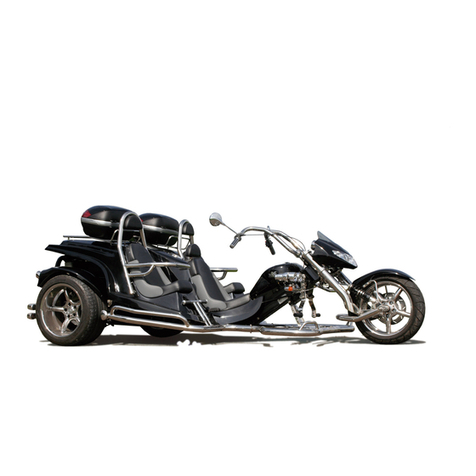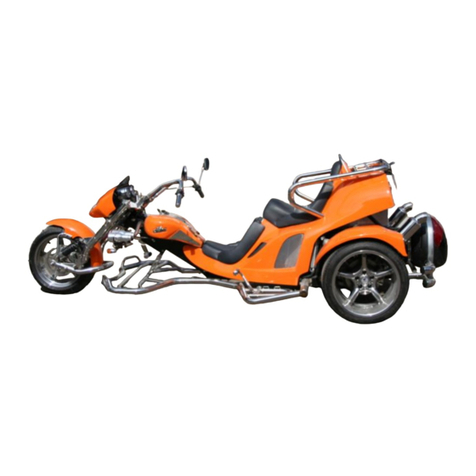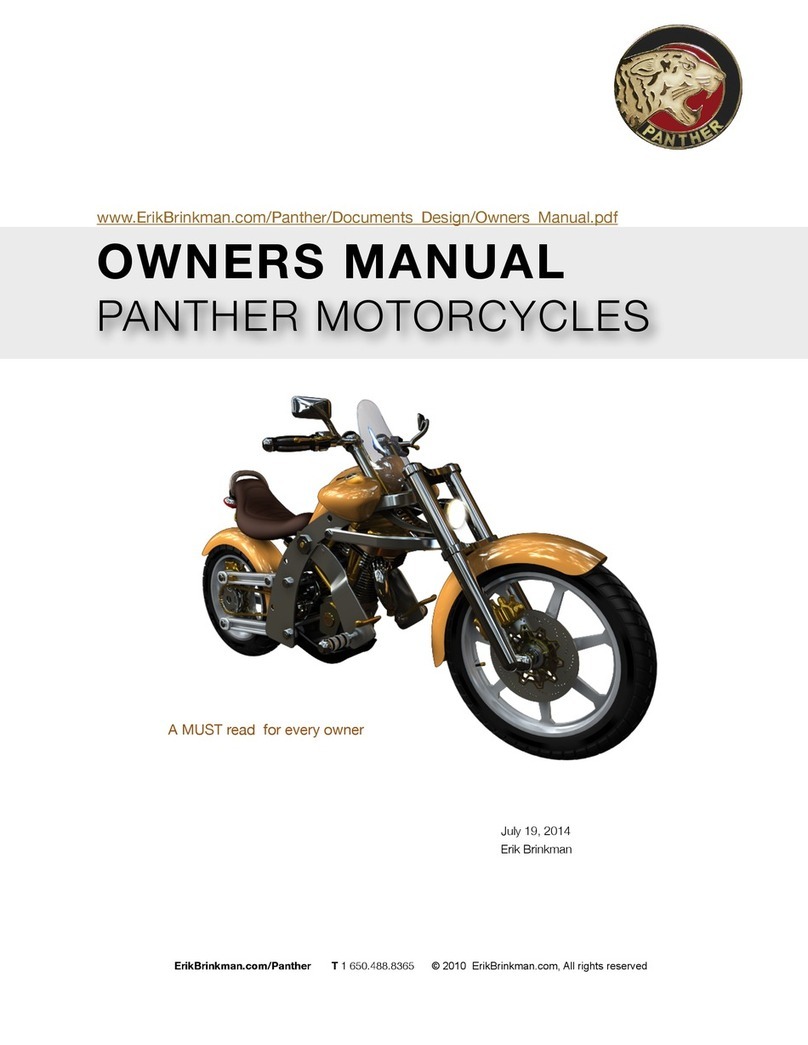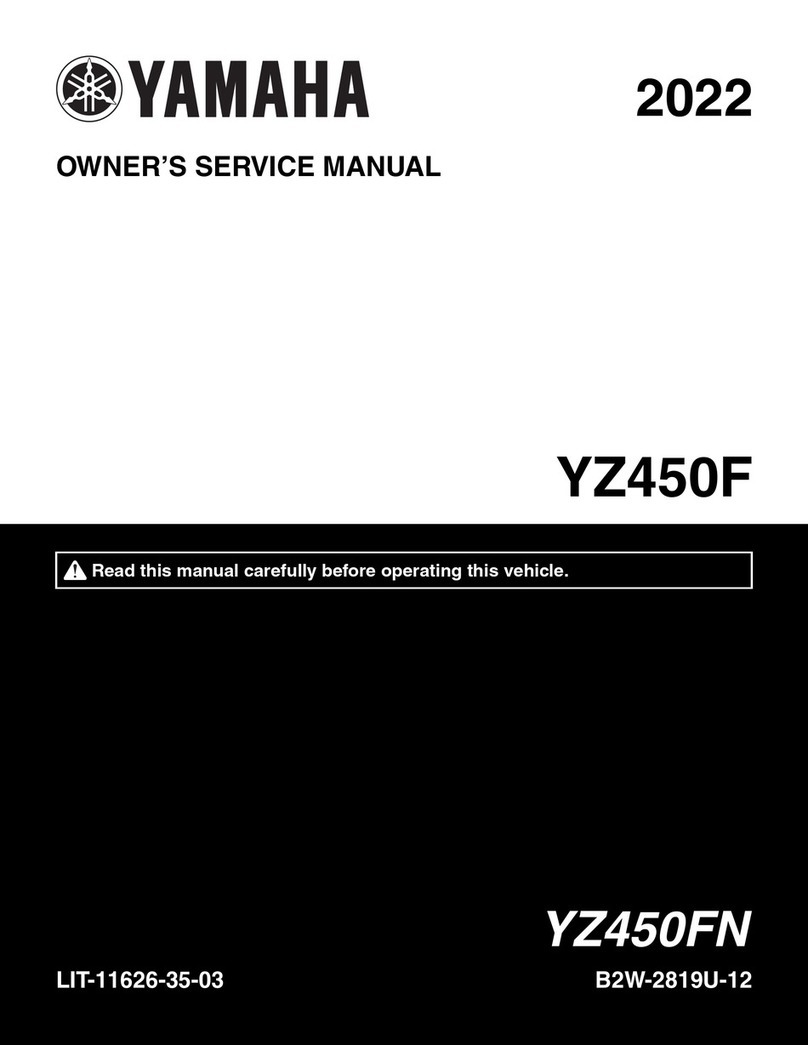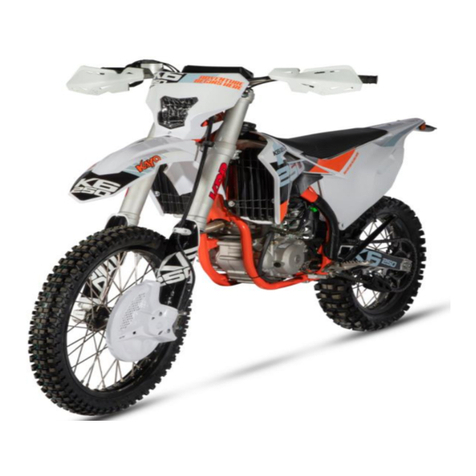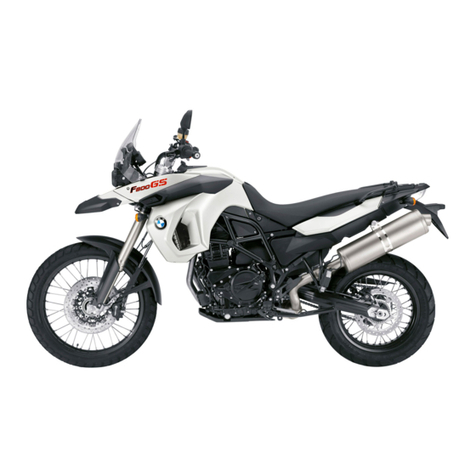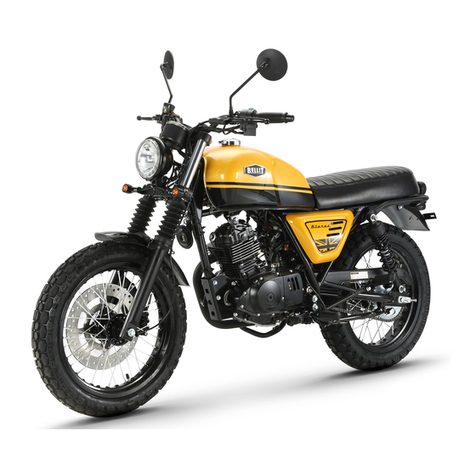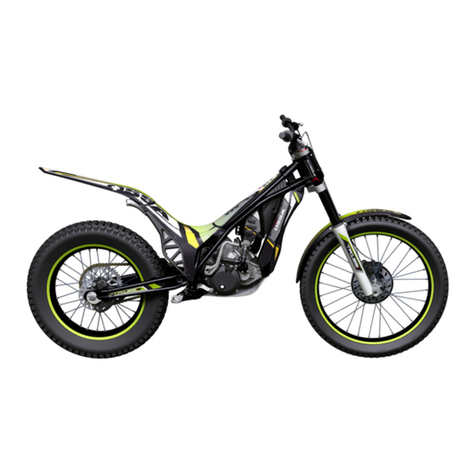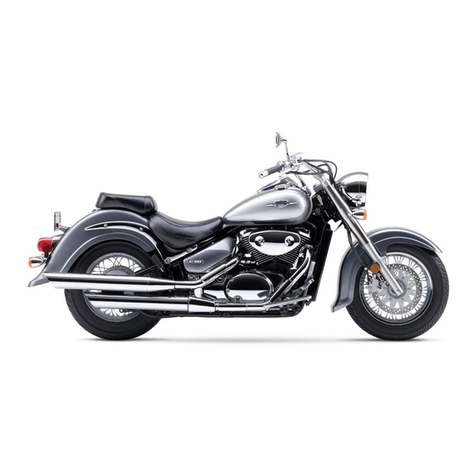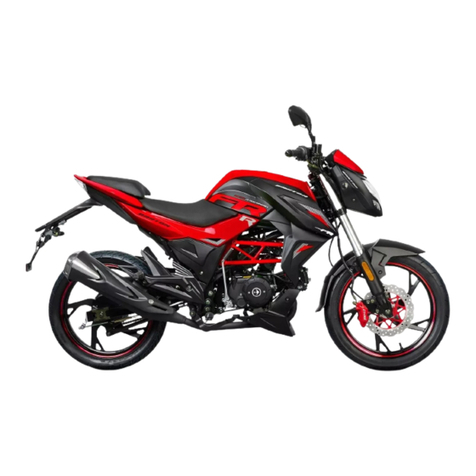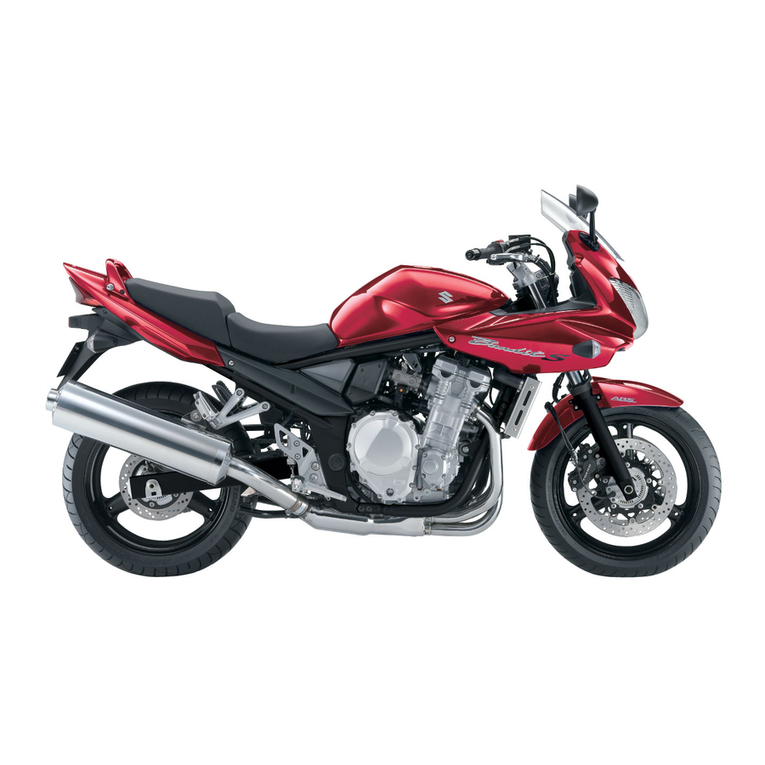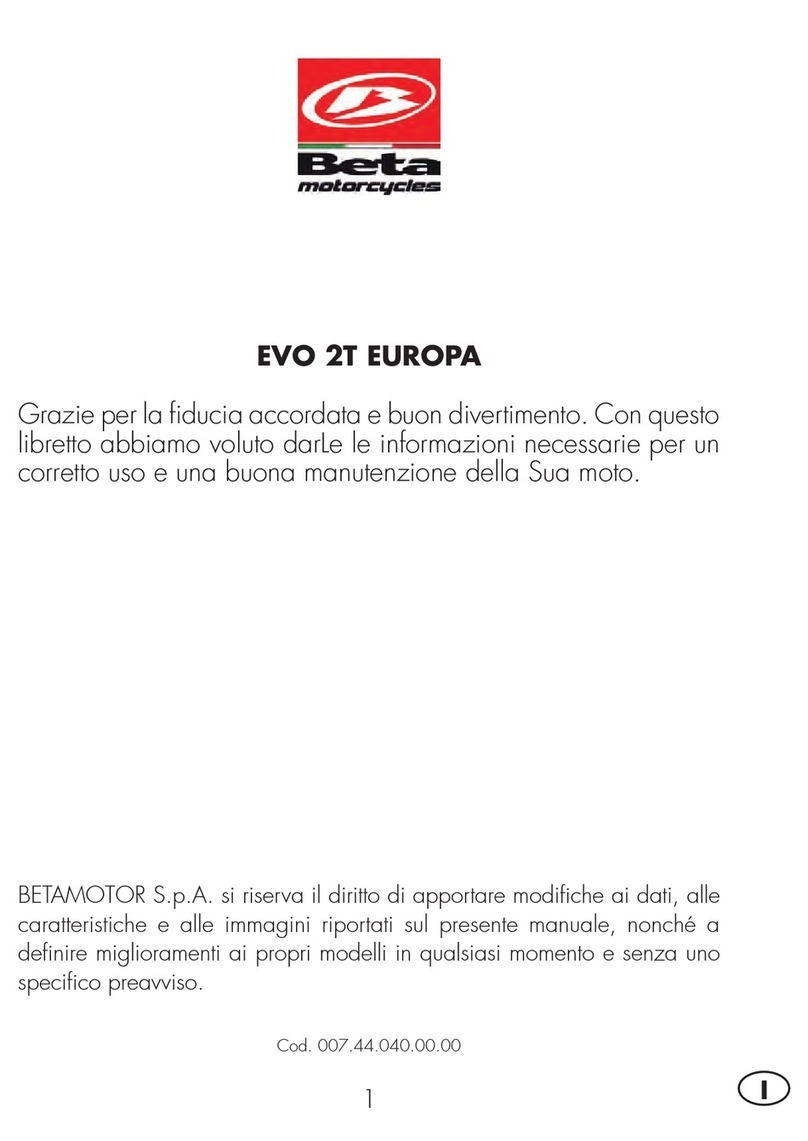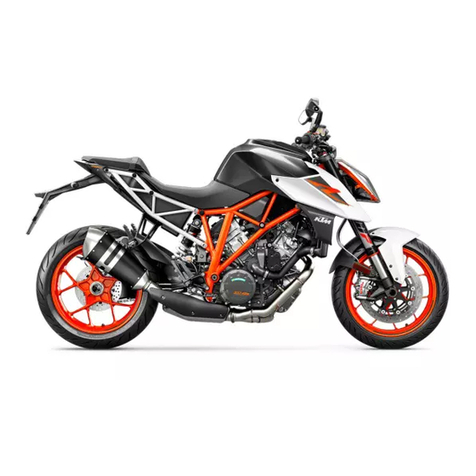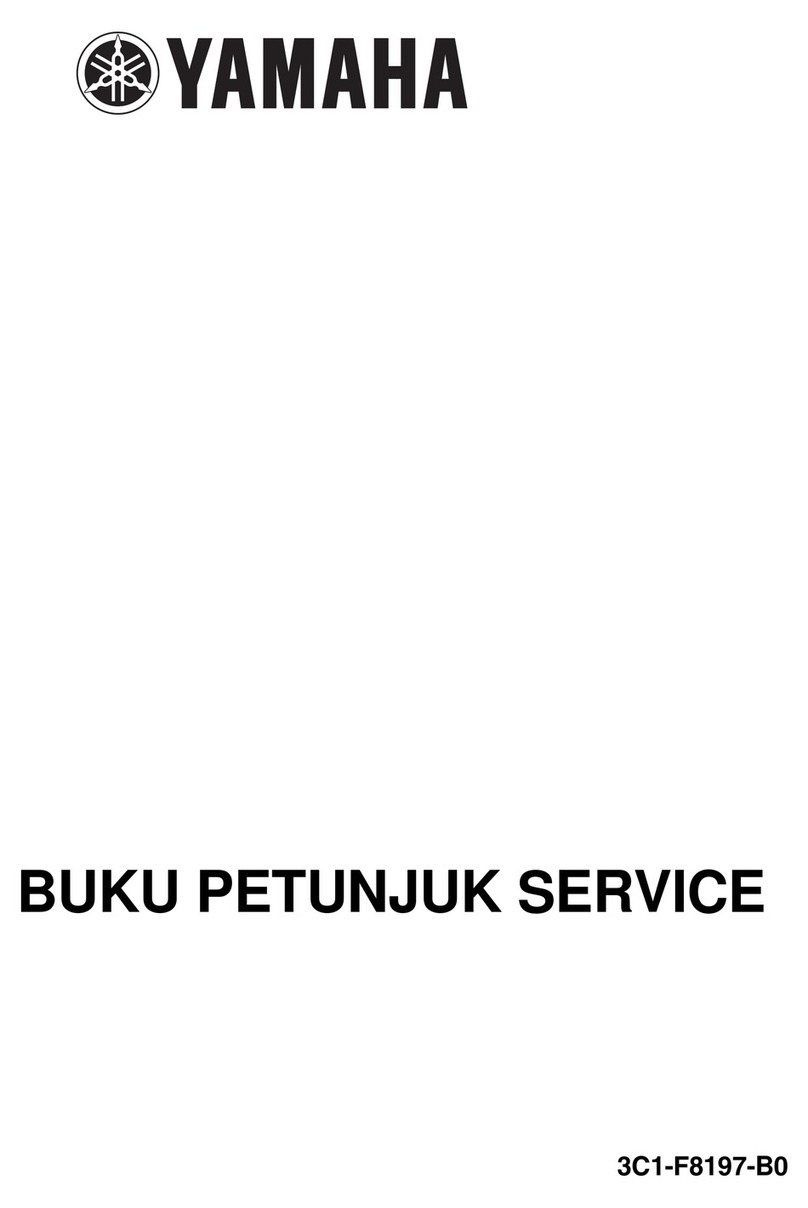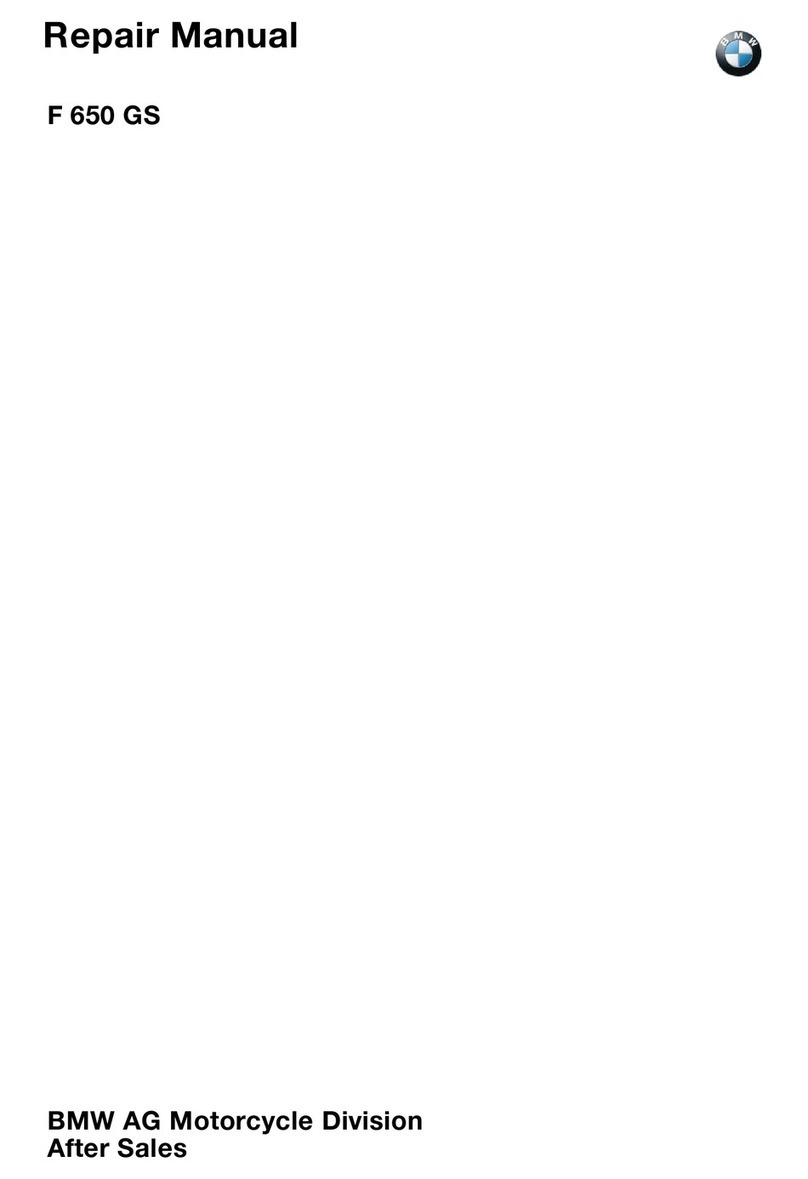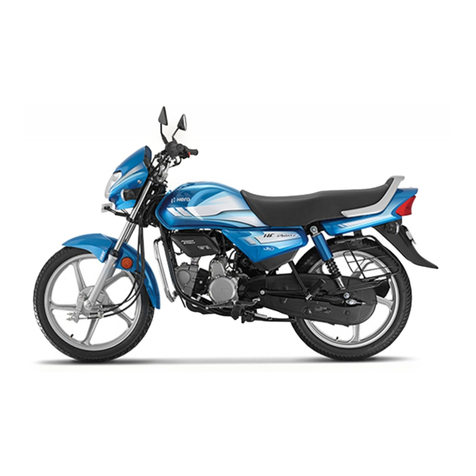BOOM TRIKES V1 AUTOMATIC User guide

V1 AUTOMATIC
OWNER'S HANDBOOK
AND
SERVICE ITINERARY
Certificated Management
Edition 04/13 System

2
F
RAME AND ENGINE NUMBERS
The frame num er is stamped on the right-hand side of the frame.
The engine num er is stamped on the drive elt housing at the rear.
IT IS ILLEGAL TO ALTER A FRAME NUMBER.
DOING SO MAY RENDER THE VEHICLE LIABLE TO CONFISCATION
Vehicle details
Technical
specifications
Model:
Cubic capacity: 460 c c
Version:
Power output: 29 kW (40 bhp)
Vehicle frame n° :
Max speed: approx 75 mph
(120 km/h)
Date first
registered:
N° of seats: 2
Owner:
Length: 3475 cm
Street:
Width: 1600-1640 cm
City/postal code:
Height: 1200-1440 cm
Phone:
Basic vehicle weight: 550 kg
Key ID n° :
Max additional weight: 180 kg
Colour:
Please present this handbook and service itinerary to your dealer whenever you bring the vehicle in
for maintenance or servicing → (summary of vehicle information for dealer)
(
(
T
TA
AB
BL
LE
E
O
OF
F
C
CO
ON
NT
TE
EN
NT
TS
S
O
ON
N
P
PA
AG
GE
E
3
3)
)
Affix engine specification sheet here

3
T
T
A
AB
BL
LE
E
O
OF
F
C
C
O
ON
NT
TE
EN
NT
TS
S
Page
1. General information and safety considerations 5 – 6
2.1 Controls, switchgear, warning lights and instruments 7 – 8
2.2 Parking lock 9
2.3 Checks efore you ride your trike 10
2.4 Running in 10
2.5 Starting the engine 11
2.6 Automatic gear ox 12
2.7 Frame, front fork, rear dampers, rear axle 12 – 13
2.8 Bodywork 14 – 15
3.0 Braking system 16– 17
3.1 Fuel system, fuel 18
3.2 Type of fuel 18
3.3 Catalytic converter 19
3.4 Battery 20
3.5 Engine oil level 21– 22
3.6 Changing the oil filter 22
3.7 Differential gear ox 23
3.8 Removing the spark plugs 24
3.9 Removing the air filter 25
4.0 Checking the cooling system 26
4.1 Adjusting the headlamps 27
4.2 Rear-view mirrors 27
4.3 Top ox and carrier 28
4.4 Tyres 29
4.5 Cleaning the vehicle 30
4.6 Putting the vehicle into storage 30
4.7 List of light ul s 30
4.8 Fuses, relays 31
4.9 Trou leshooting 32
5.0 MagCode PowerSystemPro 12/24 V 33
5.1 Wiring diagrams - legend 34
5.2 Wiring diagram, relays and fuses 35
5.3 Wiring diagrams control unit 36
5.4 Wiring diagram, lights and instruments 37
6.0 Terms of warranty / general conditions and terms of usiness 38 – 40
7.0 Service ooklet 41 – 46
8.0 Maintenance and service intervals 47 – 52
9.0 Pre-delivery vehicle checks 53

4
S
SY
YM
MB
BO
OL
LS
S
U
US
SE
ED
D
I
IN
N
T
TH
HI
IS
S
H
HA
AN
ND
DB
BO
OO
OK
K
OBSERVE PERSONAL SAFETY
CAUTION
Failure to observe these rules fully and correctly
can seriously endanger your personal safety
and health
PROTECT THE ENVIRONMENT
CAUTION
The following are hints and tips to prevent use of
the vehicle having a negative effect on the
environment
OBSERVE TECHNICAL SAFETY
CAUTION
Failure to observe these rules fully and correctly
can seriously endanger the technical safety of
the vehicle and may cause the conditions of the
warranty to become void
The symbols shown here are very important.
Wherever they have been included in this
handbook, they underline the importance of the
passages to which they refer. In such cases
even greater attention must be paid to the
instructions given. Each symbol is distinct from
the other, making it clear and easy to understand
the type of information to which they refer.
Fahrzeugbau GmbH

5
GENERAL
INFORMATION
AND
SAFETY
CONSIDERATIONS
’
SAFE LOADS AND
ACCESSORIES
If you equip your trike with accessories and ride it carrying luggage, then great care must be taken to
avoid accidents Fitting accessory parts and riding with luggage can severely affect a trike's handling
stability, vehicle performance and safe handling characteristics, and may require you to significantly
reduce riding speeds Consider also that the above mentioned effects on safe handling may become
even worse if you fit accessories made by other manufacturers, if the loads you are carrying are
distributed unevenly, if the tyres are worn, if the trike is poorly maintained, if road or weather conditions
are bad etc Always consider the above before you equip your trike with accessories or carry extra
luggage
Make sure that the combined weight of rider, passenger, luggage and accessories does not exceed
180 kg
ACCESSORIES
Original BOOM TRIKES accessories have been specially developed and tested to be compatible with
your trike BOOM TRIKES have not tested any accessories made by other manufacturers for the effects
that they may have on the handling characteristics of your vehicle
It is therefore your responsibility to find out about the safety risks and any accident risk involved if you
equip your trike with accessories made by other manufacturers
Always observe the following:
1 Check the accessory part thoroughly to make sure that it does not cover up any lights, impair ground
clearance, obstruct handlebar turns, or the use of any of the controls
2 Accessory parts which modify the riding position, increasing the distance between hands and feet
and controls, may delay a rider’s reaction in a potentially dangerous road situation
3 Do not fit any electrical parts which overload the trike's electrical system If a fuse blows, resulting in
night-time failure of lights, or if the engine cuts out in heavy traffic, a potentially dangerous situation
may arise
Caution:
Any modifications to the trike or removal of original parts may lead to the vehicle being unsafe to ride
and may also contravene existing laws Always observe all legal requirements
WHEN RIDING, ALWAYS ENSURE THAT YOU ARE FULLY IN CONTROL OF YOUR TRIKE .
NEVER RIDE UNDER THE INFLUENCE OF ALCOHOL, DRUGS OR EVEN MEDICATION.
FAILURE TO OBSERVE THIS RULE PUTS THE SAFETY OF YOUR OWN PERSON AND OF
OTHERS SERIOUSLY AT RISK.
ANY MODIFICATIONS TO THE VEHICLE’S PERFORMANCE, OR TO ITS STRUCTURAL
FEATURES, ARE ILLEGAL. IN SUCH CASES THE VEHICLE NO LONGER CORRESPONDS TO
ITS ORIGINAL AND APPROVED SPECIFICATIONS, AND IS TECHNICALLY UNSAFE TO RIDE.
NOTE
NEVER ADJUST THE REAR-VIEW MIRRORS WHILE THE VEHICLE IS MOVING, AS YOU RISK
LOSING CONTROL OF THE TRIKE.
TO AVOID ACCIDENTS, ALWAYS DRIVE VERY CAREFULLY WHEN YOU HAVE FITTED
ACCESSORIES AND WHEN THE VEHICLE IS CARRYING LUGGAGE.
RIDING WITH ACCESSORIES AND WITH LUGGAGE MAY ADVERSELY AFFECT HANDLING
CHARACTERISTICS, MAY REDUCE YOUR BOOM TRIKE’S PERFORMANCE, AND MAY
LOWER THE LIMITS AT WHICH SAFE RIDING IS STILL POSSIBLE.
WITHOUT ACCESSORIES, RIDING SPEEDS CAN BE HIGHER, BUT YOU SHOULD ALWAYS
KEEP WITHIN THE LEGALLY PRESCRIBED LIMIT. IF ACCESSORIES FROM
MANUFACTURERS OTHER THAN FROM BOOM TRIKES HAVE BEEN FITTED, IF THE
VEHICLE IS CARRYING HEAVY LOADS, IF IT IS POORLY MAINTAINED, OR IF ROAD AND
WEATHER CONDITIONS D
ICTATE, REDUCE YOUR
RIDING SPEEDS EVEN F
URTHER.

6
T
T
H
HA
AN
NK
K
Y
YO
OU
U
F
FO
OR
R
P
PL
LA
AC
CI
IN
NG
G
Y
YO
OU
UR
R
T
TR
RU
US
ST
T
I
IN
N
O
OU
UR
R
C
CO
OM
MP
PA
AN
NY
Y
A
AN
ND
D
F
FO
OR
R
P
PU
UR
RC
CH
HA
AS
SI
IN
NG
G
A
A
B
BO
OO
OM
M
T
TR
RI
IK
KE
E
C
AUTION
:
P
LEASE READ CAREFULLY
A trike is a fascinating vehicle It gives its rider a feeling of freedom, with power at his fingertips
However, you should always be aware of and accept the limits which trike riding dictates You
should carry out regular care and maintenance as a matter of course, ensuring that your trike is
always in perfect condition
Take care not only of your trike, but also of yourself When riding, you will only remain in control of
your vehicle if you are healthy and if you feel healthy Substances such as alcohol, drugs of any
kind, including those medically prescribed, should always be kept out of play, all the more so when
you are riding a trike As a trike rider you must always be in top form Consuming even minor
quantities of alcohol increases the likelihood that you will take risks
Riders of trikes and motorcycles should always choose the best in protective gear: At the very least
a full-face helmet, a full leather suit, leather boots and a good pair of gloves should be worn But do
not let your biking gear tempt you into a false sense of security Always remember: a good trike
rider exercises caution Always observe this rule to make sure you keep out of harm's way even if
others make mistakes
A trike is likely to handle in a way which is different to other road vehicles, especially in rainy or bad
weather conditions Only an experienced car driver / motorcycle rider should take charge of a trike
We urgently recommend that you take part in a trike rider's safety course
Before you take your trike out on the road always check:
- Oil and coolant levels
- Tyre pressures
- The amount of fuel in the tank
Before you take your trike out on the road always check the brake fluid level
Also check the vehicle to ensure that it is in roadworthy condition, that the lights are in working
order, and that all external parts are properly secured
Polish chrome parts regularly using an appropriate cleaner, as otherwise the warranty on these
parts of the vehicle will become void All aluminium parts are highly susceptible to corrosion, and
depending on the degree to which the vehicle is exposed to salt in the atmosphere, or to other
corrosive influences, it will require more or less frequent cleaning
As a result of continuous improvement to BOOM trikes, certain details of your trike may deviate
from the specifications contained in this handbook
SAFETY FIRST
The following is a brief guide to safe and carefree everyday riding Your knowledge of
the vehicle and your riding abilities are the key to ensuring that you travel the roads
safely Try the vehicle out on quiet roads with only occasional traffic until you are confident that you
know how to ride the trike well
1 Always wear a helmet
2 When travelling on bad roads ride slowly and with caution
3 Long journeys on wet roads without use of the brakes will cause braking performance to be
weak at first In such road conditions regularly operate the brakes to avoid this effect
4 Do not carry out emergency stops on wet roads, or on loose or slippery surfaces
5 Use of the vehicle on sand, muddy surfaces or on roads in wintery conditions: we recommend
that you regularly clean the brake discs with a light cleaning agent, to avoid dirt collecting in the
perforations which will otherwise accelerate brake pad wear
Note:
When you sell your trike, please e sure to pass this hand ook on to the
new owner

7
2.1
C
ONTROLS
,
SWITCHGEAR
,
WARNING LIGHTS AND INSTRUMENTS
Handle ar controls: (Fig. 1)
Functions:
1 Headlight flasher (at front)
2 Light switch
3 Parking light
4 Dipped beam
5 Main beam
6 Horn
7 Indicator
Fuel tank instruments / standard specifications
(Fig. 2):
1 Ignition switch
2 Water temperature gauge
(standard specifications only)
3 Rear fog light switch
4 Hazard warning light switch
5 Brake fluid warning light
3 4
Fig 2
1
2
6
7
3
4
5
Fig 1
1
5
2

8
Instruments
1 Speedometer
2 Tripometer
3 Fuel gauge
4 Flashing light
5 Oil pressure warning light
6 Main beam warning light
7 Alternator / engine fault warning light
8 Tachometer
K
NOW YOUR WARNING LIGHTS
A few seconds after you have started the engine the oil pressure warning light (red) should go off If it
stays on, stop the engine immediately and check the engine oil level Running the vehicle with
insufficient oil pressure can cause severe damage to the engine
B
RAKE FLUID WARNING LIGHT
If this light goes on, top up the brake fluid reservoir to the “Max” marking immediately Take the vehicle
to your nearest BOOM TRIKES dealer or any other specialist dealer to carry out a check on the braking
system Stop the vehicle immediately and have it towed!
A
LTERNATOR
/
ENGINE FAULT WARNING LIGHT
A few seconds after you have started the engine this light must go off If it does not go off, or if it lights
up while you are riding the vehicle, stop the engine immediately and take the vehicle to your nearest
BOOM TRIKES dealer
1
2
3
4 6
7 5
8

9
2.2
P
ARKING LOCK
To activate the parking lock, turn the handlebars to the right Insert the key, turning the barrel of the
lock to the right, press and then lock To unlock it, insert the key and proceed in reverse order
(Fig 4)
P
ROTECTING YOUR TRIKE AGAINST THEFT
1 Always activate the parking lock and never leave the ignition key unattended in the switch
Obvious though these precautions are, they are equally easy to forget
2 Make sure that your vehicle documents are complete and up to date Carry them with you but
never leave them unattended onboard the vehicle
3 If possible, lock your vehicle in an enclosed garage space
4 Write down your name, address and telephone number in this handbook

10
2.3
C
HECKS BEFORE YOU RIDE YOUR TRIKE
Caution: Failure to observe the section "Checks before you ride your trike"
can lead to accidents or damage to the vehicle
Check your trike regularly before you ride it The checks listed below take very little time to
complete and in the long run will save you time and help to protect both your wallet and your life
1 Engine oil level: Check the oil level and if necessary top up
Check the engine for oil leaks
2 Fuel: Always refuel in good time
Check the fuel lines for leaks
3 Front/rear brakes: Check that the brakes are in good working order
Ensure that there are no brake fluid leaks
4 Tyres: Check the tyre pressures and the condition of the tyres
5 Throttle: Ensure throttle action remains smooth when turning the handlebars from lock to lock
6 Lighting equipment and horn: Check that headlamp, tail light, brake light, indicators,
warning lights and horn are in proper working order
Caution: Never let the engine run in an enclosed space. Exhaust fumes
contain poisonous car on monoxide which can lead to a loss of
consciousness and ultimately cause death.
Never press the electric starter button for longer than 5 seconds at a time Always wait for at least
10 seconds before attempting to start the engine again
2.4
R
UNNING IN
Run the vehicle in over the first 650 miles / 1000 km Use only a moderate throttle during this
period, and do not overrev Vary engine speeds, avoid maintaining them constant
Never use full throttle while running the engine in
Only briefly warm up the engine at idling speed Avoid travelling short distances, as otherwise the
engine will not reach its correct running temperature

11
2.5
S
TARTING THE ENGINE
This vehicle is equipped with an ignition cutout operated by the handbrake If the handbrake is on, then
the engine will not start
This vehicle is equipped with a CVT automatic gear ox which engages directly with the rear
wheels. When starting the engine, you must press the foot rake and the throttle must e shut.
After the engine has started, release the foot rake and gently open the throttle.
The fuel injection system also comprises a vacuum pump and a choke which automatically assist engine
starts
EVEN SLIGHTLY OPENING THE THROTTLE WILL CAUSE THE AUTOMATIC GEARBOX TO TURN
THE REAR WHEELS. AFTER STARTING, RELEASE THE FOOTBRAKE VERY SLOWLY AND
GENTLY OPEN THE THROTTLE.
When you start the engine, the fuel injection system takes into account the engine temperature, ambient
temperatures, and surrounding air pressure
STOPPING THE ENGINE
Close the throttle and turn the ignition key to the OFF position Remove the key
PRECAUTIONS
TO AVOID DAMAGING THE ENGINE, NEVER RUN HIGH ENGINE SPEEDS AFTER A
COLD START. WHEN TRAVELLING DOWNHILL TAKE CARE NOT TO EXCEED
THE VEHICLE’S MAXIMUM SPEED. IF YOU EXCEED MAXIMUM ENGINE SPEED THEN A
GOVERNOR WILL BE ACTIVATED TO PROTECT THE ENGINE FROM DAMAGE.
IF YOU HAVE RIDDEN A LONG DISTANCE AT MAXIMUM SPEED, NEVER STOP THE
ENGINE IMMEDIATELY AFTERWARDS. LET THE ENGINE IDLE IN NEUTRAL
FOR A FEW SECONDS FIRST.
CARRYING OUT ALTERATIONS MAY CAUSE SEVERE DAMAGE TO THE ENGINE.
TUNING MEASURES OR ANY OTHER MODIFICATIONS TO EITHER THE
ENGINE, THE CVT AUTOMATIC GEARBOX, OR TO THE VEHICLE ITSELF WILL
INVALIDATE THE VEHICLE’S WARRANTY.

12
2.6
A
UTOMATIC GEARBOX
The V1 is equipped with a CVT automatic gearbox
To ensure the most comfortable ride possible the vehicle is equipped with an automatic gearbox, a
centrifugal clutch and electronic engine management This system was developed to obtain best
possible acceleration and lowest possible fuel consumption both on even roads and up hills If you stop
the vehicle when travelling up a hill, e g at traffic lights or in a line of traffic, use only the brakes to keep
the vehicle from rolling away Do not open the throttle, instead let the engine idle
If you use the engine to stop the vehicle from rolling ackwards, due to excessive
friction this can cause the clutch to overheat. The overheat is caused y clutch friction
on the clutch ody.
Avoid clutch friction over long periods. Other than in the situation descri ed a ove, this can
occur when on full throttle up steep hills, or when moving off on a steep hill with a passenger
and luggage.
In the event of the clutch overheating observe the following precautions:
1 Do not ride the vehicle under these conditions over a long period
2 If the clutch overheats, then let the engine idle in neutral for a few minutes to allow the clutch to cool
down
2.7 F
RAME
,
FRONT FORK
,
REAR DAMPERS
,
REAR AXLE
A) Comfort fork (maintenance-free)
B) Telescopic fork
Front suspension is by a hydraulically operated telescopic fork If the fork seals are no longer oiltight,
then take the trike to a specialist dealer to carry out repairs As the front fork is a safety-relevant part, if
problems occur we urgently recommend that you contact your specialist The front fork is a non-
adjustable unit
Each fork leg contains 270 c c of SAE 10W fork oil, which should be changed every 3 years
B) Rear dampers
Fig 5
The standard spring pre-load on the rear dampers
offers an optimum compromise for riding either on
your own or with a passenger, and in both these
cases no further adjustment is required
However, if most of the time the trike carries a
passenger and large amounts of luggage, then
adjust the pre-load to a higher setting (A)

13
ADJUSTING THE REAR DAMPERS
An adjuster wheel at the lower end of the unit allows continuous adjustment of the spring pre-load
SPRING PRE-LOAD WHICH IS INCORRECT FOR THE RESPECTIVE WEIGHT OF THE
VEHICLE CAN IMPAIR THE QUALITY OF THE RIDE AND MAKE IT UNSAFE TO USE THE
TRIKE.
TO AVOID INJURY OR ACCIDENTS, WEAR PROTECTIVE GLOVES WHENEVER YOU
ADJUST THE DAMPERS.
ALWAYS ADJUST BOTH DAMPERS TO EXACTLY THE SAME SETTING.
C) Rear axle
The rear axle is equipped with alloy swinging arms on either side Snail cam adjusters A+B allow you to
set toe-in and camber
All V1 trikes are set up correctly at the factory and will normally need no further adjustment
The factory settings are:
Toe-in: - 0° 10‘ to - 0° 15‘
Camber: 0°10‘
If tyre wear is uneven, then please contact a specialist dealer who can check camber and toe-in and if
required make the necessary adjustments
Fig 6

14
2.8
BODYWORK
The bodywork is made of ABS plastic When cleaning please observe the following:
Fig 7
Do not use petrol or spirits!
We recommend an anti-static spray cleaner for plastic surfaces
Spray the surfaces and wipe them dry with a soft, lint-free rag
This will avoid a buildup of static and prevent
dust particles from collecting on the surface
Normally available in 500 ml bottles
This spray cleaner is available from your BOOM trikes dealer
We also recommend that you use a soft rag to clean other plastic parts – not a microfibre rag – and that
you do not use sponges or rags which have rough cleaning surfaces
Fig 8
To lift up the body section, press the lever (Fig 8) respectively on standard equipment trikes loose the
body work connection
Fig 9

15
After unlocking, press the body section up
The liftomatic raises the body and holds
it in place
To lower the body section, first press the body
up to release the locking mechanism of the liftomatic
Fig 10
Make sure that the handle ars are straight, i.e. the front wheel is pointing straight ahead, and
that the hand rake is on. Otherwise you will e una le to lift up the ody section fully, and will
also risk damaging it.
Caution:
Whenever you ride the trike and whenever you tow the vehicle on an open
trailer the ody section must always e shut (using the liftomatic
mechanism, or having secured it with olts). When you close the ody
section make sure to lower it slowly, evenly and towards the centre of the vehicle, as
otherwise you risk damaging the odywork or the side covers.

16
3.0
B
RAKING SYSTEM
A)
B
RAKE PEDAL
Fig 11
B) F
RONT DISK
The front brake, operated by the integral braking system, is a legal requirement Unlike a motorcycle,
80 % of braking loads are transmitted to the rear wheels, even at high speeds Nevertheless, you should
regularly check the front brake for wear, and the brake lines for any leakages
Caution: The raking system should e maintained and repaired y specialist dealers only.
C)
R
EAR BRAKE
Fig 12
CAUTION:
The vehicle must egin to slow down after the rake pedal has een depressed a out
one third of the way. Your specialist dealer will check for rake pad wear. If he fits new
rake pads, and efore you ride the vehicle, you should actuate the rake lever several
times to ensure that the rake pistons return to their proper positions and so that
rake lever travel readjusts itself.
Wear to the brake pads and the discs is compensated by the
system and has no effect on braking performance Therefore as a
rule no adjustment to the brakes will be required
If resistance at the brake lever is spongy, then in all likelihood air
has entered the brake lines Since the brakes are of major
importance to the overall safety of the trike, we urgently
recommend that you contact a specialist dealer immediately to
have him carry out the necessary checks
To adjust the brake pedal, remove the cotter pin 1 and
undo the nut 2 securing it (arrow) Now the pedal can be
adjusted Undo the nut on the footrest mounting and
remove the screws Now the footrest mounting can be
adjusted
Consider that sufficient ground clearance is given!
←
←←
←

17
D)
H
ANDBRAKE
The full effect of the handbrake should be felt at the fourth
click
If not, then access the linkage nuts depicted below to re-adjust
If this produces no results, then the brake pads will need to be
replaced (Fig 13)
If the handbrake is on, then the engine will not start If the engine
is running, then pulling the handbrake will stop the engine
Fig 13
E) CHECKING THE BRAKE FLUID LEVEL
The brake fluid reservoir for the front and rear brakes is situated beneath the plastic fuel tank To check
the brake fluid level you must first remove the tank
TOPPING UP WITH BRAKE FLUID
Recommended brake fluid: DOT 4 Lucas.
Proceed as follows:
Remove the cover of the brake fluid reservoir If necessary pull off the electrical connector When
topping up use only the brake fluid prescribed Never exceed the upper marking (MAX)
USE ONLY DOT 4 BRAKE FLUID.
BRAKE FLUID IS A HAZARDOUS LIQUID. AVOID CONTACT WITH EYES, SKIN OR
CLOTHING. IN THE EVENT OF CONTACT, IMMEDIATELY RINSE THE AFFECTED AREA
THOROUGHLY WITH RUNNING WATER.
BRAKE FLUID IS HYGROSCOPIC, I.E. ABSORBS MOISTURE. IF BRAKE FLUID
CONTAINS TOO MUCH MOISTURE, THEN BRAKING PERFORMANCE WILL
DETERIORATE. NEVER USE BRAKE FLUID WHICH HAS BEEN STORED IN AN
UNSEALED CONTAINER.
In a normal climate brake fluid should be changed every 12500 miles / 20,000 km, or at least every 2
years Always contact a specialist dealer to let him carry out this task
The brake fluid level, brake pad thickness, as well as the thickness of the discs should be checked at
regular intervals
! To ensure maximum braking performance from your brake discs, run them in over a distance of
approximately 120 miles / 200 km
During this period avoid making emergency stops
After leaving a car wash, or in rainy and generally wet road conditions gently press the brake pedal to
remove moisture from the disc !
Fig 14
The brake fluid level must always be between MIN and MAX markings
If the brake fluid level has receded, then this can be due to brake pad
wear If the fluid is below the MIN marking, then you should
contact a
specialist dealer and have him carry out a thorough check of the braking
system If brake fluid is below the MIN marking, then the brake fluid
warning light will go on

18
3.1
F
UEL SYSTEM
,
FUEL
Caution:
Petrol is highly inflammable, and under certain conditions can cause explosions Always refuel
in a well ventilated area, and make sure that the engine is off Never smoke while refuelling or
when in a fuel storage area; make sure that there are no naked flames nearby and that sparks cannot
occur Do not overfill the fuel tank When you have finished refuelling, the pipe between the filler cap
and the tank should be empty
Make sure to close the filler cap properly Do not spill any fuel Petrol fumes and spilled petrol are easily
ignited In the event of spillage make sure that the area in question is dry before you restart the engine
Avoid repeated or prolonged contact with skin and do not inhale petrol fumes
Keep out of reach of children!
Caution: Never let the engine’s fuel pump run dry. This takes only a few seconds and
damages the fuel pump eyond repair!
The filler pipe is located under the upper part of
the passenger's backrest
Fig 15
3.2
T
YPE OF FUEL
Use only 95 octane petrol
Caution: Vehicles equipped with a catalytic converter may use unleaded petrol only. If y
mistake you have filled up with leaded petrol (even a minor amount), then on no account
start the engine, as this will damage the catalytic converter eyond repair.
BOOM TRIKES accept no responsibility for damage caused by the use of leaded petrol Such damage
shall be excluded from the conditions of warranty If by mistake you have filled the tank with leaded fuel ,
then please contact an authorised BOOM TRIKES dealer, or a specialist dealer

19
3.3 C
ATALYTIC CONVERTER
Never allow petrol to enter the catalytic converter, especially when the engine is hot:
- Never use up all the petrol in the fuel tank
- Avoid prolonged attempts at starting the engine
- Use attery jump leads
- Never turn off the ignition while the vehicle moving
Caution: If the ignition system malfunctions, or if performance is below normal, contact an
authorised BOOM TRIKES dealer, or a specialist dealer Do not use full throttle
The catalytic converter is uilt into the exhaust silencer. Exhaust system
temperatures can reach 1000 °C. Never park the vehicle in places where the
surrounding vegetation can catch fire (woods, lawns etc.)
NEVER RIDE THE VEHICLE ON AN ALMOST EMPTY FUEL TANK. IF THE PETROL
SUPPLY IS INTERRUPTED, DAMAGE MAY OCCUR TO THE CATALYTIC
CONVERTER AND THE FUEL PUMP IS SURE TO BE DAMAGED BEYOND REPAIR
USE OF A NON-RECOMMENDED FUEL NEGATIVELY AFFECTS THE PERFORMANCE
OF THE EXHAUST AND FUEL SUPPLY SYSTEMS.
NEVER RUN THE VEHICLE UNTIL THE FUEL TANK IS COMPLETELY EMPTY. IF THIS
OCCURS, DO NOT MAKE REPEATED ATTEMPTS AT STARTING THE ENGINE.
TURN THE IGNITION TO THE “OFF“ POSITION AND FILL UP WITH PETROL AS SOON
AS POSSIBLE. FAILURE TO OBSERVE THESE INSTRUCTIONS CAN LEAD TO THE
FUEL PUMP AND/OR CATALYTIC CONVERTER BEING DAMAGED BEYOND REPAIR.
YOU ARE STRONGLY ADVISED NOT TO USE FUEL FROM ANY OTHER SOURCES
THAN NORMAL FILLING STATIONS. SUCH SUPPLIES MAY BE
CONTAMINATED AND MAY DAMAGE THE FUEL SYSTEM’S PETROL FILTERS.
USE OF LUBRICANTS OTHER THAN THOSE WHICH HAVE BEEN RECOMMENDED CAN
ACCELERATE WEAR IN THE ENGINE

20
3.4 B
ATTERY
(12V-18AH)
The battery is the part of the electrical system requiring closest attention and care The most important
rules for maintaining a battery are as follows:
Maintenance-free atteries
First-time use of a maintenance-free battery:
Caring for a maintenance-free battery is confined to checking the battery voltage and if necessary
charging the battery Checking the battery voltage must be carried out before the vehicle is delivered A
disconnected battery kept in storage must be charged every 6 months Prior to delivery of the vehicle, in
addition to the maintenance above, you must check the voltage and charge the battery every 6 months
Charging a disconnected attery kept in storage:
1) Checking the attery voltage
Before connecting the battery to a vehicle use a normal voltage tester to check the voltage of the
disconnected battery
- If the battery voltage exceeds 12 6 V, you may connect the battery to the vehicle
- If the battery voltage falls below 12 6 V, then charge the battery as described under 2)
2) Charging a attery at a constant voltage rate
- Charge at a constant voltage rate between 14 4 and 14 7 V
- Initial charging current: a 0 3 to 0 5 x nominal voltage
Duration of charge:
Recommended: 10 – 12 hours
Minimum: 6 hours
Maximum: 24 hours
NEVER REVERSE THE CONNECTIONS TO THE BATTERY TERMINALS: THIS WILL CAUSE
SHORT CIRCUITING AND RISKS DAMAGING THE ELECTRICAL SYSTEM.
NEVER DISCONNECT THE BATTERY TERMINALS WHEN THE ENGINE IS RUNNING, AS THIS
CAN CAUSE IRREPARABLE DAMAGE TO THE ELECTRONIC IGNITION SYSTEM.
A SPENT BATTERY IS AN ENVIRONMENTAL HAZARD. RESPECT ENVIRONMENTAL LAWS AND
DISPOSE OF IT IN AN APPROPRIATE CONTAINER.
If the vehicle is stationary for prolonged periods, then the battery will gradually discharge This is due to
natural discharging and due to consumers which are permanently supplied with electricity
The rate at which the battery discharges also depends on ambient conditions and on whether the battery
terminals are kept clean
To avoid starting difficulties and severely damaging the battery, observe the following rules:
-
At least once a month: start the engine and run it for 10 – 15 minutes at engine speeds slightly
above idling speed This keeps both the battery and the engine components in functional order
-
When you put the vehicle into storage (see instructions in the section „Putting the vehicle into
storage“) remove the battery from the vehicle Clean the battery, give it a full charge, and store it in a
dry and well ventilated place Charge the battery at least once every two months
-
It is recommended to use a current conservation unit which will be connected to the battery with an
adapter cable The battery needs not to be removed and is connected permanently to the charger
while the vehicle is put into storage
Table of contents
Other BOOM TRIKES Motorcycle manuals
